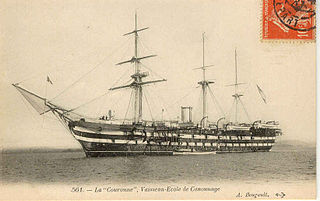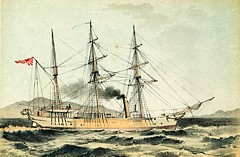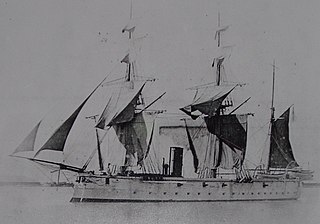
A frigate is a type of warship. In different eras, the roles and capabilities of ships classified as frigates have varied.

A ship of the line was a type of naval warship constructed during the Age of Sail from the 17th century to the mid-19th century. The ship of the line was designed for the naval tactic known as the line of battle, which involved the two columns of opposing warships manoeuvering to volley fire with the cannons along their broadsides. In conflicts where opposing ships were both able to fire from their broadsides, the faction with more cannons firing – and therefore more firepower – typically had an advantage.

An ironclad was a steam-propelled warship protected by steel or iron armor constructed from 1859 to the early 1890s. The ironclad was developed as a result of the vulnerability of wooden warships to explosive or incendiary shells. The first ironclad battleship, Gloire, was launched by the French Navy in November 1859, narrowly preempting the British Royal Navy. However, Britain built the first completely iron-hulled warships.

During the 18th and 19th centuries, a sloop-of-war was a warship of the British Royal Navy with a single gun deck that carried up to 18 guns. The rating system of the Royal Navy covered all vessels with 20 or more guns; thus, the term encompassed all unrated warships, including gun-brigs and cutters. In technical terms, even the more specialised bomb vessels and fire ships were classed by the Royal Navy as sloops-of-war, and in practice these were employed in the role of a sloop-of-war when not carrying out their specialised functions.

Steam frigates and the smaller steam corvettes, steam sloops, steam gunboats and steam schooners, were steam-powered warships that were not meant to stand in the line of battle. The first such ships were paddle steamers. Later on the invention of screw propulsion enabled construction of screw-powered versions of the traditional frigates, corvettes, sloops and gunboats.

A screw sloop is a propeller-driven sloop-of-war. They were popularized in the mid-19th century, during the introduction of the steam engine and the transition of fleets to this new technology.

USS Merrimack, also improperly Merrimac, was a steam frigate, best known as the hull upon which the ironclad warship CSS Virginia was constructed during the American Civil War. The CSS Virginia then took part in the Battle of Hampton Roads in the first engagement between ironclad warships.

Jylland is a Danish frigate, and is both a screw-propelled steam frigate and a sailship. It took part in the Battle of Heligoland on 9 May 1864, and is preserved as a museum ship in the small town of Ebeltoft, located on the Djursland peninsula in Denmark.

Napoléon was a 90-gun ship of the line of the French Navy, and the first purpose-built steam battleship in the world. She is also considered the first true steam battleship, and the first screw battleship ever.

USS Contoocook was a screw sloop-of-war built for the United States Navy during the American Civil War. She is named after a river and village in New Hampshire. She was launched 3 December 1864 at Portsmouth Navy Yard and commissioned 14 March 1868, commanded by Captain George Balch.

The French ironclad Couronne ("Crown") was the first iron-hulled ironclad warship built for the French Navy in 1859–1862. She was the first such ship to be laid down, although the British armoured frigate HMS Warrior was completed first. The ship participated in the Franco-Prussian War of 1870–1871, but saw no combat. She was served as a gunnery training ship from 1885 to 1908 before she was hulked the following year and became a barracks ship in Toulon. Couronne was scrapped in 1934, over 70 years after she was completed.

Hōshō was a screw sloop, originally built in the United Kingdom for Chōshū Domain in western Japan, and subsequently served in the early Imperial Japanese Navy.

The Amazon class was a class of six screw sloops of wooden construction built for the Royal Navy between 1865 and 1866.

Jorge Juan was a Jorge Juan-class sloop of the Spanish Navy which was sunk off Cuba during the Spanish–American War.
USS Wanaloset, also spelled USS Wanalosett, was a proposed United States Navy screw sloop-of-war or steam frigate that appears never to have been laid down.
USS Keosauqua was a proposed United States Navy screw sloop-of-war or steam frigate that was cancelled in 1866 without being completed.
USS Willamette was a proposed United States Navy screw sloop-of-war or steam frigate that was cancelled in 1866 without ever having been laid down.

An unprotected cruiser was a type of naval warship that was in use during the early 1870s Victorian or pre-dreadnought era. The name was meant to distinguish these ships from “protected cruisers”, which had become accepted in the 1880s. A protected cruiser did not have side armor on its hull like a battleship or “armored cruiser” but had only a curved armored deck built inside the ship — like an internal turtle shell — which prevented enemy fire penetrating through the ship down into the most critical areas such as machinery, boilers, and ammunition storage. An unprotected cruiser lacked even this level of internal protection. The definitions had some gray areas, because individual ships could be built with a protective deck that did not cover more than a small area of the ship, or was so thin as to be of little value. The same was true of the side armor on some armored cruisers. An unprotected cruiser was generally cheaper and less effective than a protected cruiser, while a protected cruiser was generally cheaper and less effective than an armored cruiser, with some exceptions in each case.

The Ister-class frigates were a group of five 36-gun screw frigates ordered for the Royal Navy in the early 1860s. Four of the ships were cancelled after they were laid down and HMS Endymion was the only ship completed.















